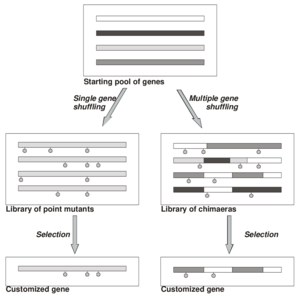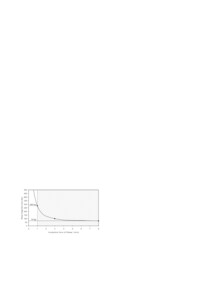Random Mutagenesis by DNA Shuffling
| Cat. No. | Amount | Price (EUR) | Buy / Note |
|---|---|---|---|
| PP-103 | 15 reactions | 314,60 | Add to Basket/Quote Add to Notepad |


For general laboratory use.
Shipping: shipped on gel packs
Storage Conditions: store at -20 °C
avoid freeze/thaw cycles
Shelf Life: 12 months
Description:
JBS Mutagenesis Series
Within three billion years of evolution, nature has produced a plethora of proteins simply by repeated cycles of random mutagenesis followed by in vivo selection for superior function of the encoded proteins. This example of natural evolution has guided researchers within the last two decades to develop strategies for in vitro permutation of proteins.
Among the variety of strategies applied, three major powerful techniques have emerged.
Random Mutagenesis by dNTP Analogs
This method is based on the incorporation of mutagenic dNTP analogs, such as 8-oxo-dGTP and dPTP, into an amplified DNA fragment by PCR. The mutagenic dNTPs are eliminated by a second PCR step in the presence of the four natural dNTPs only, resulting in a rate of mutagenesis of up to 20%.
→ JBS dNTP-Mutagenesis Kit #PP-101
Random Mutagenesis by Error-Prone PCR
Developed by Caldwell & Joyce (1992) this method introduces mutations in the gene of interest using a PCR reaction under conditions that induce an increased error-rate of the DNA-polymerase. The rate of mutagenesis achieved by error-prone PCR is in the range of 0.6-2.0%.
→ JBS Error-Prone Kit #PP-102
Random Mutagenesis by DNA Shuffling
Developed by Stemmer (1994) DNA shuffling generates libraries by random fragmentation of one gene or a pool of related genes, followed by the reassembly of the fragments in a self-priming PCR reaction. This method allows the recombination of sequences from different, related genes. The overall rate of mutagenesis is approx. 0.7%.
→ JBS DNA-Shuffling Kit #PP-103
Jena Bioscience now offers all components necessary for each of these techniques 'ready-to-go' in a separate kit, accompanied by a streamlined documentation that maximizes success.
Content:
DNase I (yellow cap)
0.1 units/μl, 100 μl
Digestion Buffer (blue cap)
10x concentration, 100 μl
DNase Stop Solution (yellow cap)
100 μl
Taq Polymerase (red cap)
5 units/μl, 40 μl
Shuffling Buffer (green cap)
10x concentration, 200 μl
dNTP Mix (white cap)
10 mM each dNTP (dATP, dCTP, dGTP,dTTP), 40 μl
PCR-grade Water (white cap)
3x 1 ml
Random Mutagenesis by DNA Shuffling
DNA shuffling is a powerful technique for directed evolution of proteins in vitro. It generates structural diversity by recombination of gene fragments originating from one or several related genes.
DNA shuffling can be divided into single gene shuffling and multiple gene shuffling (Fig. 1). In single gene shuffling only one gene is digested and subsequently reassembled resulting in point mutations at a rate of approx. 0.7%.
The major application of DNA shuffling in protein evolution is multiple gene shuffling (often referred to as molecular breeding). In this technique several homologous DNA sequences are digested and subsequently reassembled. The result is a library of chimaeric genes containing additional point mutations.
A pivotal step in DNA shuffling is the digest of the gene of interest for production of fragments of appropriate size. Therefore, all reagents in the Kit are optimised to obtain fragments of the desired size within a convenient time frame (Fig. 2).
Usually best results were achieved using fragments with mean sizes of 70-280 bp. Note that a complete DNase I digest results in very short fragments that cannot be amplified by subsequent PCR.
Recommended assay preparation
1. DNase I digest of gene(s) of interest
2. First PCR (without primers)
3. Second PCR (with primers)
BIOZ Product Citations:
Selected References:
Crameri et al. (1998) DNA shuffling of a family of genes from diverse species accelerates directed evolution. Nature 391:288.
Patten et al. (1997) Applications of DNA shuffling to pharmaceuticals and vaccines. Curr. Opin. Biotechnol. 8:724.
Stemmer (1994) DNA shuffling by random fragmentation and reassembly. In vitro recombination for molecular evolution. Proc. Natl. Acad. Sci. USA 91:10747.
Stemmer (1994) Rapid evolution of a protein in vitro by DNA shuffling. Nature 370:389.